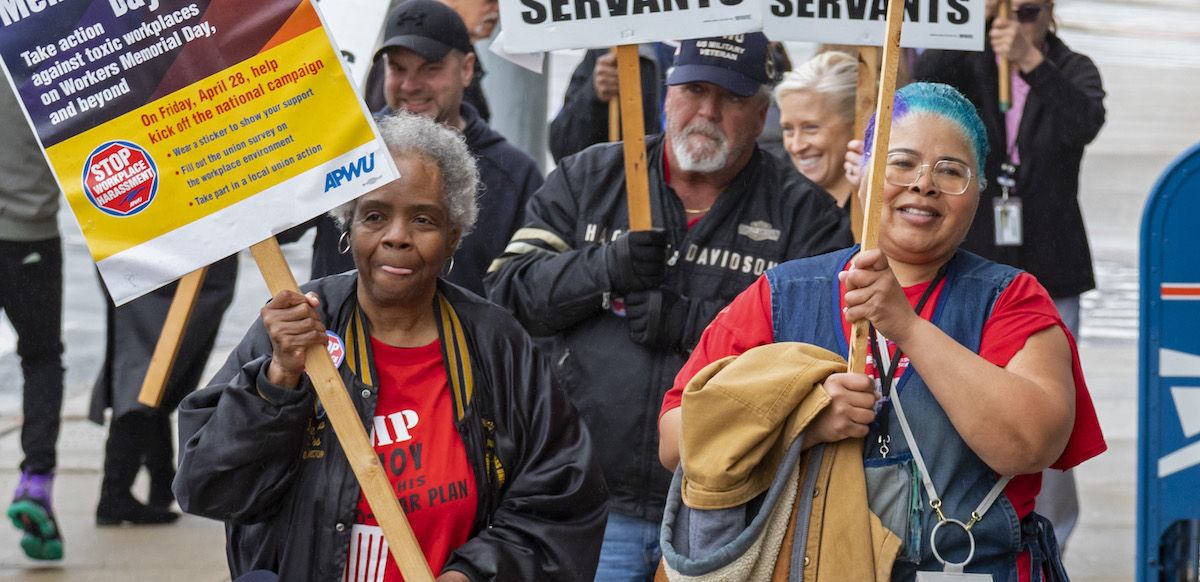Viewpoint: Awful Conditions in New Postal Hubs Create an Opening for Resistance

Postal workers rallied last April at Detroit's main post office to protest worsening working conditions. Photo: Jim West, jimwestphoto.com
For three years, rank-and-file postal workers and community allies have been fighting Postmaster General Louis DeJoy’s Ten-Year Plan to Amazonify the postal service.
DeJoy’s overall goal is eliminating jobs by installing huge new automated parcel sorting machines. For letter carriers, the biggest immediate impact of his multi-pronged plan is relocating many from neighborhood post offices to massive new Sorting and Delivery Centers. Over the next few years 600 of these hubs would be set up, impacting 6,000 post offices and 100,000 routes.
Under pressure from Senators, DeJoy announced May 13 that he will pause another part of the plan, the consolidation of mail processing plants, at least until next January—a big win for our side. But it looks like we’re going to be stuck with S&DCs in many places for some time.
The silver lining is that these hubs, which pack together hundreds of letter carriers from five to 10 zip code “spokes,” could become an organizing opportunity—a base for letter carriers to build power.
SHOP FLOOR FRICTION
A handful of these S&DCs have already opened, and we’re hearing horror stories about the shoddy rollout:
- Inadequate bathrooms—one had Porta-Potties for a year.
- Not enough parking, lockers, or breakroom space.
- Not enough floor and dock space to accommodate all the sorting cases and machinery—so mail piles up and there’s no room to move a forklift.
- Lengthy treks through the plant—from where you pick up the mail to where you sort it, where you get your keys, where your truck is parked, and so on.
- Dangerous new travel—after sorting the mail you drive a long way back to your delivery neighborhood, sometimes on freeways, in rickety vehicles that start to shake above 50 miles an hour.
- Overburdened delivery routes that already took longer than eight hours—now with added travel time.
Local management in the new S&DCs is scrambling, unsure what to do. They hadn’t planned the details. They’re going to have to hire more carriers and adjust routes, but turnover for entry-level carriers is already above 50 percent. Is this an opening to take matters into our own hands?
Carriers are upset about the burdensome and unsafe conditions. Just to get the mail out, they’re going to have to develop a new culture of cooperation. Lots of their gripes will be good organizing issues, small enough to win and big enough to matter (bathrooms!). And after you win one fight, the next comes easier.

SUPPORT LABOR NOTES
BECOME A MONTHLY DONOR
Give $10 a month or more and get our "Fight the Boss, Build the Union" T-shirt.
What if letter carriers elected five or 10 shop stewards and alternates (our contract allows one of each per 50 carriers) who became a core of shop floor organizers? What if they used the tools available, even without an illegal strike or “slowdown”:
- Taking over or establishing safety committees
- Interrupting the “stand-up” (a daily briefing by local management) to air grievances
- Wearing buttons or stickers
- Circulating petitions and marching on the boss
- Filing group grievances
- Lining up to submit multiple form 1767s (Hazardous and Unsafe Conditions or Practices)
- Working to rule (for example, taking a full five minutes to check your vehicle or go to the bathroom)
- Refusing unsafe work (for example, walking and driving in ice, heat, or smoke; working outside after dark; long hours that cause dangerous fatigue)
- Going public about our conditions with press releases, press conferences, rallies, and picket lines
What if they set up text-message chat groups for each row of sorting cases (or the entire facility), the smokers’ group, the carpool groups (many will be organized for the long commute from each “spoke” zip code), and the large group of lower-paid carriers in the City Carrier Associate and Part-Time Flexible tiers—chats that could become centers of agitation and direct action?
ORGANIZING KNOW-HOW
No doubt among the hundreds of carriers in each S&DC there are some with organizing experience, some with shop steward experience, some who have read Secrets of a Successful Organizer—or will read it now to learn how to identify the best issues, map workplace chokepoints, find natural leaders, and pull together an organizing team.
We need to keep fighting the rollout of S&DC hubs and try to save our local post offices. We need to keep pushing our national union leaders to launch all-out pressure campaigns to return to 2012 delivery standards, reopen the closed and reduced processing plants, and dump DeJoy and his Ten-Year Plan.
But in the meantime, we can use this restructuring to build shop floor power, win better conditions, and develop a new layer of militants among letter carriers.
Jamie Partridge is a retired member of Letter Carriers (NALC) Branch 82 and active in Communities and Postal Workers United.





